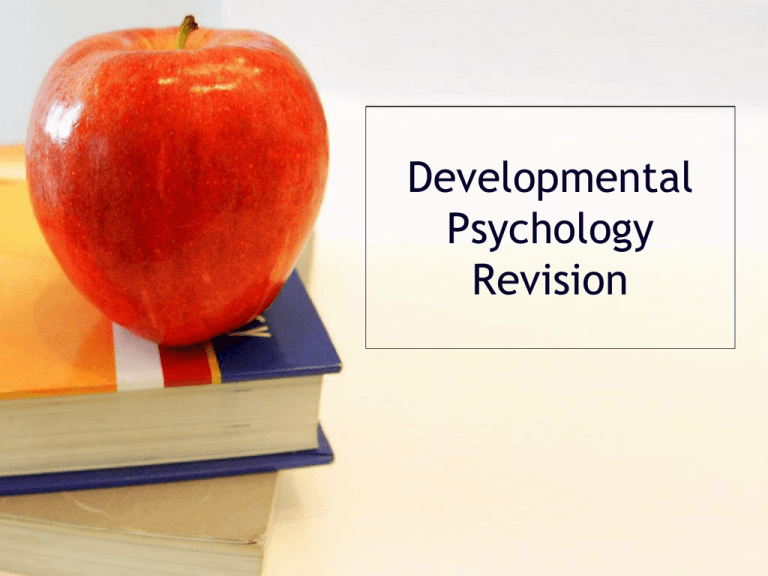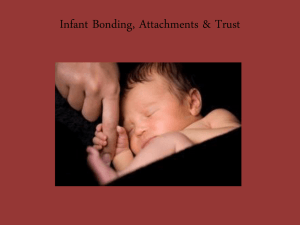
Developmental
Psychology
Revision
Syllabus
Developmental Psychology
Attachment
•What is attachment
•Explanations of attachment (learning theory; Bowlby’s evolutionary
theory)
•Types of attachment (SECURE, insecure AVOIDANT, INSECURE RESISTANT)
•Ainsworth’s strange situation RESEARCH
•Cross cultural variations in attachment
•Disruption to attachment (separation) – Research and Effects
•Privation – research and effects
Attachment in
everyday life
•What is day care
•Impact of day care on social development (aggression and peer relations)
•How attachment and day care research has influenced child care
Key terms
• Attachment
– a close emotional relationship between
TWO persons, characterised by mutual
affection, a desire to maintain p________
and d_________ upon separation
• At what age do the first attachments
start to form?
Explanations of Attachment 1
LEARNING THEORY
•
Attachments are learnt and are based on the
provision of FOOD and are LEARNT through
CLASSICAL and OPERANT conditioning
•
CLASSICAL conditioning = Child learns to
ASSOCIATE the PCG (NS) with food (UCS).
Repeated associations lead to the PCG causing
feelings of Pleasure (CR)
2.
OPERANT conditioning = Child learns to attach to
the PCG because the PCG provides FOOD (Positive
Reinforcement). PCG is the SECONDARY
REINFORCER, the food they provide is the PRIMARY
REINFORCER as it satisfies a basic drive
•
Also forming an attachment removes the stress
associated with a crying baby. This is NEGATIVE
REINFORCEMENT
EVALUATION
• Face Validity – makes sense that
we form attachments to the
person who provides food
• Contradictory evidence from
HARLOW...
• Other contradictory evidence –
Shaffer and Emerson found that
a high number of a sample of
children tested did not attach
to the person who provided
food
•
INCOMPLETE – Many examples
of children whose primary
attachment is NOT with the
person who feeds them. Must
be other explanations
Explanations of Attachment 2
BOWLBY’S EVOLUTIONARY THEORY
•Attachments have an EVOLUTIONARY BASIS as
they are ADAPTIVE. This is because they
INCREASE THE CHILDS CHANCES OF SURVIVAL
because…
EVALUATION
•
Lots of supporting AND
contradictory evidence (e.g.
Genie, Czech Twins)
•
Incomplete – many of Bowlby’s
ideas have been criticised
–
•Other features of Bowlby’s theory…
–
•MONOTROPY which is…
•A child has a CRITICAL PERIOD in which they
must form an attachment. The critical period
is…
•If a child does not form attachment, Bowlby’s
MATERNAL DEPRIVATION HYPOTHESIS suggests
there will be major negative consequences,
including…
•
many children have multiple
attachments which appears to go
against the idea of monotropy
The notion of the critical period
is too strict. Many children will
develop attachments outside of
this and suffer no negative
consequences (e.g. Czech Twins).
A ‘sensitive period’ is more
appropriate
Too Simplistic – focus is too much
on the role of the mother and
underestimates the role of the
father
Level of DISTRESS on
separation (low to high)
Types of Attachment
•
3 types
•
NOTE - When describing each attachment type, mention (1)
child’s behaviour when separated from PCG. E.g. Level of
Distress shown (2) child’s behaviour towards strangers (3)
child’s behaviour when reunited with PCG
•
Type A – INSECURE - ________________
–
•
Type B - _________________
–
•
Child shows less distress when separated by PCG; Child avoids contact
with PCG and can be comforted by others just as easily
Child shows moderate distress when separated from PCG; Easily
comforted by PCG; Discriminates between PCG and others; Child uses
PCG as a safe base
Type C – INSECURE - ________________
–
Child shows high distress when separated from PCG; When PCG tries to
comfort the child they resist them (push them away)
Ainsworth’s Studies
•
STRANGE SITUATION – allows us to
identify the attachment type of a child
Evaluation – be prepared to comment on VALIDITY
and ETHICS
•
Research Method = Controlled
observation
•
8 Episodes – learn the general procedure
•Low external validity and mundane realism artificial environment and task so behaviour OF THE
MOTHER is likely to be unnatural. May tell us little
about attachments in real world
•
What is observed…
–
infants responses to separation from
PCG
–
Infants response to being re-united
with PCG
–
Infants behaviour when alone
–
Infants behaviour when with a
stranger
•High control over environment and extraneous
variables so study has high I________ V___________
•Easy to replicate (due to standardised procedure) so
high R___________
•ETHNOCENTRIC procedure – developed with relation
to WESTERN NORMS so the procedure may not be
appropriate for use in other cultures
•ETHICAL issues because…
AND ONLY IF ASKED ABOUT AINSWORTH’S STUDY…
•Low population validity because Ainsworth’s original
study only used… so cannot generalise these
conclusions to the population at large
What FACTORS contribute to the
different attachment types?
• CULTURE
–
The child rearing norms of each culture will significantly influence the attachment of
children (e.g. Germany, Israeli Kibbutz) – See later slides
• MATERNAL SENSITIVITY
–
The sensitivity of the mother (how well they respond to the childs needs) influences
attachment
• A sensitive mother is one who responds appropriately to a childs needs. These are likely to
have SECURE attachment children
• An insensitive mother may NOT respond to her child, leading to an Insecure AVOIDANT
attachement
• An insensitive mother may respond INCONSISTENTLY to a child, leading to an insecure
RESISTANT attachment
• EXTENSION - Infant temperament
–
Some children have a natural temperament which influences their attachment type
(and the way the mother responds).
• Difficult temperament = insecure attachment
Cultural Variations in Attachment
•
•
Van Ijzendoorn and Kroonenberg - Meta
Analysis of Strange Situation research in
different Countries
Conclusions
–
–
•
GROSSMAN – Found a higher % of
___________ in Germany.
–
–
•
TYPE B Secure attachments most common
in ALL cultures
VARIATIONS in attachment levels across
cultures, refelcting that different child
rearing norms impact on attachment types
This is because…
So in the strange situation German
Children would…
TAKAHASHI found a higher % of
___________ in Japan
–
–
This is because…
So in the strange situation Japanese
Children would…
EVALUATION
•Can use the general evaluation points about
the strange situation PROCEDURE (validity
issues, ethical issues)…
•A clever point refers to the inappropriate
use of the strange situation. It is an
ethnocentric procedure (developed in
relation to Western Norms) so it may not be
an appropriate procedure to use to measure
attachments in different cultures. This
means results may lack validity and may not
accurately reflect attachment levels
Disruption and Privation
DISRUPTION
•When a child is separated from the PCG for
a period of time AFTER the attachment has
been formed.
•Situations which may lead to disruption
include…
•Children will go through 3 stages in
response to separation, which are P____
D_____ D_____
•Case study of John Indicates this
•But the case study of Jane indicates the
factors which may reduce the negative
effects of disruption…
PRIVATION
•When a child is prevented from forming an
attachment, so the situation must occur…
•Privation occurs due to ABUSE, NEGLECT or
INSTITUTIONALISATION (being raised in an
institution from birth)
•Privation is likely to have NEGATIVE effects
including developmental dwarfism, intellectual
retardation, affectionless psychopathy
•Case study of Genie demonstrates this
•However, the ‘Czech Twins’ case study indicates
that certain FACTORS influence a child’s response
to this type of privation, including…
•But there are problems with case studies…
•INSTITUTIONALISATION is a particular form of
privation you have to know about…
Privation - Institutionalisation
HODGES and TIZARD
•Children who experienced institutionalisation were poorer across
measures of social, intellectual and emotional development
compared to non institutionalised children.
•However, those who were restored to families and those who
were adopted experienced a degree of improvement (adopted
group = greater improvement – why?)
•THIS SHOWS that the effects of institutionalisation will be
influenced by the length of time the child remains in the
institution and the quality of subsequent care
RUTTER
•Studied Romanian orphans who had been brought to the UK
•Romanian Orphans were significantly developmentally retarded
but improved when moved to UK institutes / families. Those
adopted late had the greatest problems (marked disinhibited
attachment)
•Shows that institutional care is likely to have negative effects
but that the quality of the institute and the time spent in the
institute will significantly influence these effects
EVALUATION
•Use of Natural Experiment is an
ETHICAL way to investigate this
area
•Problems with participant
attrition as both studies are
longitudinal. This reduces the
sample size making the
conclusions less valid regarding
the effects of institutionalisation
on everyone
•Sample issues –
unrepresentative because… may
tell us little about the effects of
institutionalisation for everyone.
Other people may have a
different response
Factors which influence the response to
disruption and privation
DISRUPTION
•Quality of care during
separation (e.g. presence of
a substitute attachment
figure who provides
consistent appropriate care)
•AGE of child
•Child’s attachment type
•Sex of the child
•Experiences of previous
separations
PRIVATION
• Quality of care during
privation /
institutionalisation
• Length of time spent in
privation / in the institution
• The age of the child when
removed from the privation
• The quality of the
subsequent care and the
experiences of the child in
later life
Day Care and Social Development
• Day Care refers to temporary care of children under school
age (5yrs) by persons other than the child’s
parents/guardians
• Can include...
– Nursery care
– Nanny / au pair
– Registered Childminder
• Social Development – skills and behaviours which impact on
the socialisation process, e.g. AGGRESSION and PEER
RELATIONS (number and quality of friendships)
One study which shows day care
has POSITIVE effects on
aggression (i.e. children in day
care show lower levels of
aggression
One study which shows
day care has NEGATIVE
effects on aggression (i.e.
children in day care show
higher levels of aggression
One study which shows day care
has POSITIVE effects on peer
relations (i.e. children in day care
have more friends and better
quality friendships
Research into the
effects of day care on
social development
One study which shows
day care has NEGATIVE
effects on peer relations
(i.e. children in day care
have fewer friends and
poorer quality friendships
Remember your format (A, M, P, R, C). Remember to Conclude and
Apply. For big marks, explain WHY day care has the effects…
Why is research into day care mixed?
EVALUATION of Research
•
Each Study uses different samples so each study suffers from low population validity.
Conclusions may not generalise to the population at large and may tell us little about the
effects of day care for all children
•
Studies investigate different types and quality of day care. Again this makes it difficult
to compare studies get a complete picture about the effect of day care in general
•
There is no objective measure of social development - Different measures of social
development are used in each study (e.g. Interviews with teachers, questionnaires,
observations); all have S&W’s which may influence results, including…
•
Also, research is purely correlation which is a problem because we cannot imply CAUSE
AND EFFECT. We cannot be sure therefore that the effects seen are a DIRECT RESULT OF
DAY CARE and not another aspect (e.g. the home life of the child)
•
BUT each study does have a number of strengths, such as Practical Applications as they
help identify the factors which day care should have in order to have a positive impact on
social development
how has research into attachment and day
care influenced child care practices
• This basically is asking you what we have
learnt from research in this area and how
can this be used to improve childcare?
• Be prepared to make SUGGESTIONS
about how to improve child care. Make
sure you JUSTIFY these with reference
to research/theory
• In addition, make sure you can identify
the features of good quality child care
Low Child – Carer ratio /
Key Worker
Important because… it
ensures the child has a
substitute attachment figure
who can provide specific,
appropriate care and
attention
Well Trained Staff
Important because… it
ensures the staff are aware of
the different needs of
children and how to respond
to children at different
developmental stages
Low Staff Turnover
Important because…
it ensures staff have
time to develop
relationships with
children and learn
their specific needs
Stimulating
Environment and an
appropriate curriculum
Important because… it
ensures children are
intellectually and socially
stimulated which will aid
development
Features of
Good Quality
Child Care
Family / Parental involvement
Important because… it ensures day care staff
are aware of the specific needs of the child.
Having the parents their initially may also
make the transition to day care less distressing
for the child.
How has child care been influenced by
research into day care and attachment?
•
“Robertson’s case study of John indicates children will experience negative effects
(e.g. They will go through P-D-D) when separated from their PCG (e.g. During child
care).
•
However, the case of Jane shows us these effects can be reduced if the child has
individual care and a substitute attachment figure during the separation. Jane was
cared for by Robertson herself and there were no other children, meaning she
received adequate care and attention. As a result, Jane suffered very few negative
effects.
•
THE IMPLICATION OF THIS is that child care should provide a substitute attachment
figure as this will reduce the negative impact of the separation.
•
THIS CAN BE ACHIEVED BY employing a Key Worker strategy (which is...) or by
having a low child-carer ratio (ideally...) as this ensures each child has a substitute
attachment figure who can provide adequate quality care and satisfy their needs.
Other ideas
•
Ainsworth’s research has indicated that the presence of strangers can cause a child distress when
the PCG is not present
–
•
Day care research has indicated that good quality day care can have positive effects on social
development (e.g. Andersson)
–
•
Child care should therefore be high quality, for e.g. A intellectually and socially stimulating environment,
varied tasks to aid the childs development
Sensitivity is the key to a how a child develops attachment (according to the maternal sensitivity
hypothesis, sensitive care givers = secure attachment)
–
•
Child care should therefore involve small groups (fewer strangers) as this will cause lower anxiety for the
child. Also, PCG should be allowed to be present during the initial child care sessions. Further, child
should be allowed to bring in their own toys (this creates a familiar environment which aids the transition)
Child care should therefore employ skilled, well trained staff who are sensitive to the children's needs
(and respond appropriately). Also, a low staff turnover is key as this ensures staff have enough time to
spend with the children and learn their specific needs.
Day care research has indicated a ‘dose effect’ – the more time a child spends in day care
initially, the more negative effects there will be. Also, most children form their initial
attachment at around 6 months
–
Children should therefore start with a few hours of child care and gradually build this up (this will lessen
the impact of the transition). Also, children should not start child care until 12 months as before this
time, the primary attachment will not be fully formed (so disruption is likely to have major negative
developmental effects)
KEY STUDIES
• HARLOW (criticism of learning theory / support of
evolutionary theory)
• BOWLBY ‘44 thieves’ (support of maternal deprivation
hypothesis / negative effects of separation)
• AINSWORTH – strange situation (attachment types)
• Van IJZENDOORN and KROONENBERG – cultural variations in
attachment; GROSSMAN; TAKAHASHI
• ROBERTSON – John and Jane case studies (effects of
separation)
• GENIE and CZECH TWINS (effects of privation)
• HODGES and TIZARD; RUTTER (effects of institutionalisation)
• (for e.g.) ANDERSSON & SHEA – day care has positive effects
on social development (Andersson = peer relations; Shea =
aggression)
• (for e.g.) DiLALLA & NICHD – day care has negative effects on
social development (Dilalla = peer relations; NICHD =
aggression)








